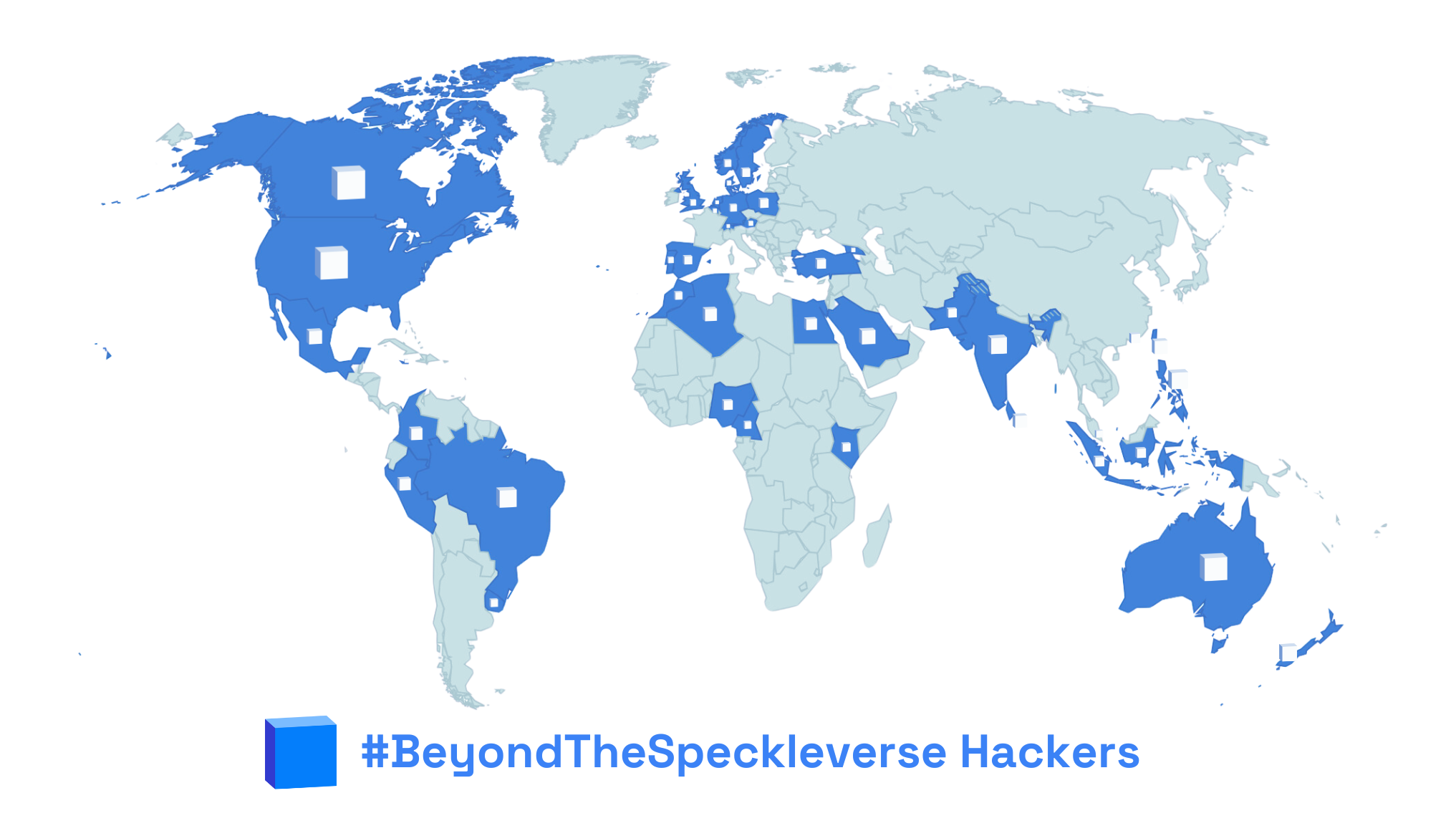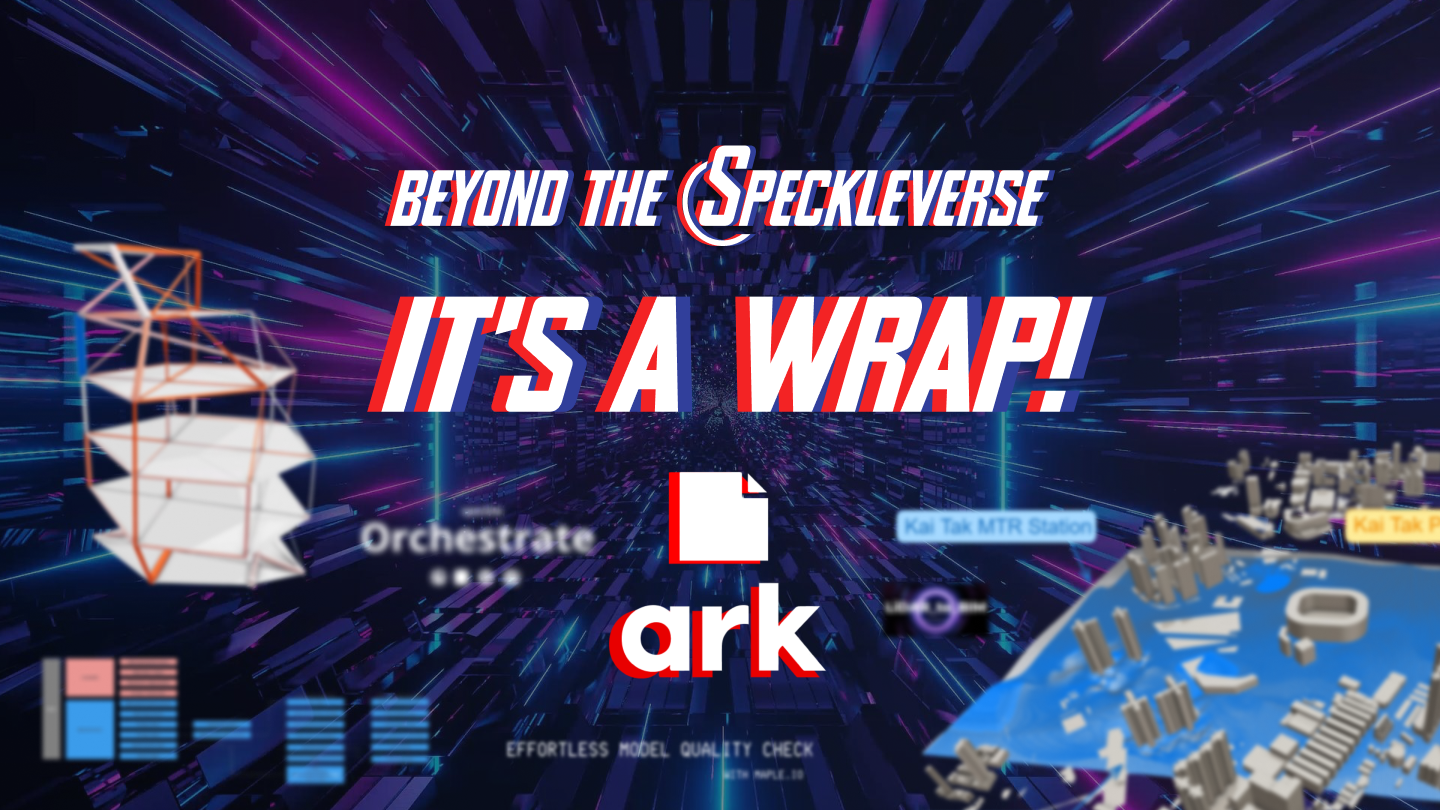With more than 280 participants (a whopping 211% more than in the first Speckle hackathon) from more than 30 countries, Beyond the Speckleverse resulted in 23 outstanding innovative AEC applications (77% more than last time).

This is the place to learn about the winning project in the hacker's own words and discover what this year's judges think about the apps!
Winning Speckle Hackathon Projects
🏆 First Place Overall: ark
The winning team: Victor Wanderley Barbosa, Zuzanna Czapla, Adam Burnham, Daniel Boba and Ellen Berglund
The drag-and-drop-files-to-Speckle dream come true! This project aimed to sympathise with the smaller AEC companies, the start-ups and the freelancers.
"We want to use Speckle's open-source features to create a much cheaper alternative. This is where ark comes in", says the team.
It's an alternative project document platform. You can upload documents (Rhino or Revit), and ark automatically generates deliverables, prints drawings, publishes the data to Speckle, and lets you view it online and share it!
You can drag and drop files directly into the website, automatically converting them to Speckle objects. You can view them on the web app; no software is needed. It also automatically prints and displays the drawing sets that are saved in the 3 DM and RVT models.
The application's front end is developed using TypeScript and the Vue.js framework. The backend has been developed in C#. The app then connects to the native APIs to facilitate the management of 3D models from Revit and Rhino, respectively.
What's next for ark: The team plans to add more file types and develop the UI further. Merging files into versioning history and developing the drawing section UI.
Most Impressive Use Of Business Intelligence: What.If.Architect
The winning team: Wyeth Binder, Matthew Tam and Steffen Samberger
The team's approach to the problem addresses communication within the structural and architectural design process. For example, "What if I remove a column?"
Their hack focused on the scenario of removing a column and the effect this design change has on the other structural elements in the building.
They have created a web interface to re-visualise the impact on other members and understand the "influence" of a singular design decision.
The hack uses Karamba3D in Rhino to send analysis results to Speckle for various model states. The native Speckle geometry is re-visualised based on selected scenarios to help users make decisions.
The next stage of this project's development is to create a dynamic workflow that allows real-time calculations and analysis for individual user input. Stay tuned!
Mücahit Bilal Göker, BI Category judge
Most Impressive Project Pulse: Speckle Orchestrate & Coordinate
The winner: Joscha During
"This nifty tool generates and interpolates your weekly work diaries from last week's commits. No more scratching your head on Monday mornings", shares Joscha.
Using the n8n connector developed during the hackathon, CommitChronicals (an n8n workflow) fetches commit messages from selected Speckle branches, filtering by user and timeframe.
It does the same for GitHub commits. The data is aggregated by date and fed to ChatGPT with instructions to create confident and vibrant workday descriptions.
Even "commit-less" days get filled in by interpolating between tasks of other days, generating a natural-sounding summary of the week.
The Speckle Orchestrate graph can drive external visualisations embedded in Notion. Users can see the entire project at a glance, with outdated branches highlighted in red, real-time status updates, and the ability to dive into the numbers.
Kateryna Konieva, Project Pulse judge
This forward-thinking project is jumping in the heart of the workflow automation problem with a great n8n integration and a strong vision for the future.”
Martha Tsigkari, external Project Pulse judge
Most Impressive Future Craft: LiDAR_to_BIM
The winning team: Agustina Aboy Berrutti, Pablo Gancharov, Julio Sarachaga, Emilio Bartolini and Martin Daguerre
"A while ago, we discovered the powerful yet handy tool of LiDAR scanning on smartphones. We thought it would be great if these scans could be integrated into BIM workflows. Speckle emerged as a great interoperability tool to get the scan models into Dynamo and Revit", says the winning team.
With this application, you can scan any environment with a smartphone with LiDAR capability. The geometries and tags are uploaded to Speckle using their custom Python connector. Once in Speckle, the team used Dynamo to read the tags' information and interpret the geometries to create Revit objects.
They have created an initial Dynamo script that identifies wall tags and extracts their geometries, allowing the creation of Revit walls according to user-selected Wall Types. Next, they plan to expand this functionality to include other elements like doors, windows, and furniture, further enhancing the integration of LiDAR scans into BIM!
The LiDAR_to_BIM and AI2Speckle: Textures Search teams both delivered on that front to strengthen the feedback between the real world and the digital."
Claire Kuang, Future Craft judge
Most Impressive Use Of Automate: Effortless model quality check with Maple
The winning duo: Andres Buitrago and Gizem Demirhan
"We think that testing is a key part of continuous integration, and we want to make it easier to write tests and ensure quality in AEC projects. We got inspiration from testing libraries for front-end development, like Cypress", the team points out.
Maple is a library designed to write simple code that can check different attributes of a Model in Speckle.
Using Maple you can write test specs that check any parameter or quantity inside the project model. Maple can be integrated into Speckle Automate to run the quality check tests on continuous integration and ensure project standards.
They built the library using Python, leveraging the Speckle Py SDK and Speckle automate functions. They used the Chai chain capable of behavioural syntax to provide assertions in a readable language.
mp.it("checks window height is greater than 2600 mm")
mp.get('category', 'Windows')\
.where('speckle_type', '...Revit.RevitInstance')\
.its('Height')\
.should('be.greater', 2600) What's next for Effortless model quality check with Maple? To allow more assertions like "clash detection" and let the library users create their own assertions.
If we ever want to reach AI nirvana, we must produce correct data. Well done, Andres and Gizem! I can’t wait to see more!
Dimitrie Stefanescu, Automate judge
Viki Sándor, external Automate judge
Most Impressive Low-Code/No-Code Implementation: Kai Tak MGM JV
The winning team: Andrei Sandor, Martijn van Blijswijk, Arda Arslan, James Holcombe and Joost Gevaert
"A Hong Kong-based area, which was previously an airport, offers much room for (re)development. We are looking at creating an underground rail connection through this area", says the team about their starting point.
The team mapped underground spaces using geological and GIS data, creating a voxel model in Python to depict soil types, foundations, and infrastructure. Based on this model, they applied a beam search algorithm to find the optimal tunnel route.
Geological data were visualised and manipulated in QGis and Rhino, then integrated into Speckle, a data storage and transfer platform. In Civil3D and Dynamo, building foundations and infrastructure were modelled.
The voxel model, developed in Python with xarray, sent data to Speckle to update and classify each voxel block for tunnelling suitability. Speckle was pivotal in coordinating the project across various sub-teams.
Popular Vote Winner: AI2Speckle: Textures Search
The winning team: Jordana R., Abhishek S., Josie Harrison and Marwan Elzainy
The "AI2Speckle" workflow enhances architectural models by integrating AI and Speckle technologies.
It starts with a landing page enabling users to access a Speckle Stream Viewer through authentication. Users then enter a prompt into an AI Image Renderer, which generates images.
Users can either continue, re-render or change their prompt depending on their satisfaction. Next, the AI Image Analyzer identifies and segments components like floors and walls in the image, suggesting the top three matching textures from PolyHaven for each. Users can either apply these textures directly to their Speckle model or download them.
The workflow could expand to include a broader range of commercial materials, improving architects' access to suitable materials. Moreover, the potential to recognize materials from photos could integrate real-world materials into models, enhancing the utility and reach of Speckle in connecting web apps with traditional architectural software.
You can get your Speckle account today and subscribe to our newsletter below if you'd like to receive more content like this:
We're thankful to our hackathon judges, both internal and external, who faced the tough yet rewarding duty of selecting our winners: Murat Melek, Aaron Atkinson, Viki Sándor, Martha Tsigkari, Mücahit Bilal Göker, Claire Kuang, Kateryna Konieva, and Dimitrie Stefanescu.

